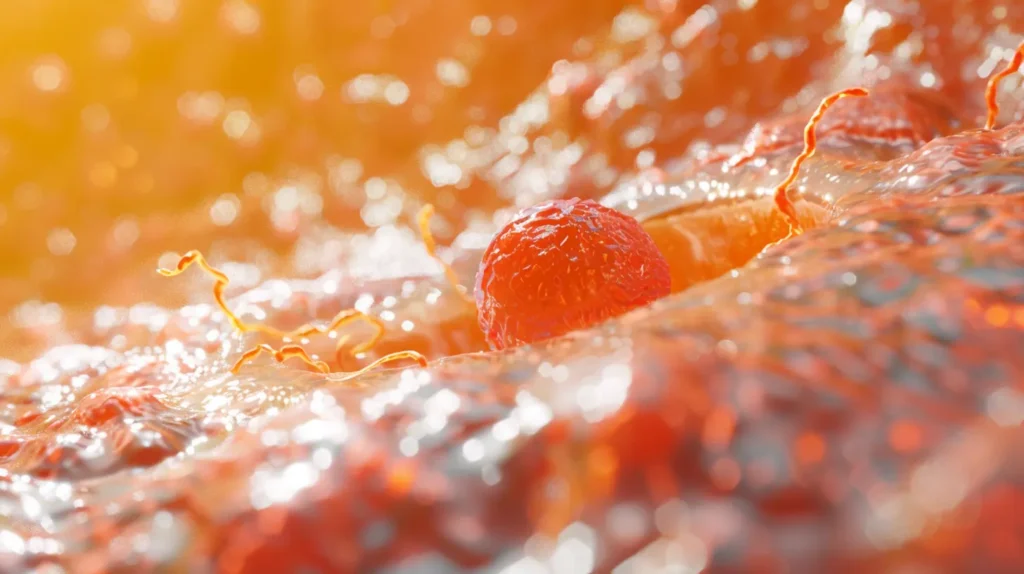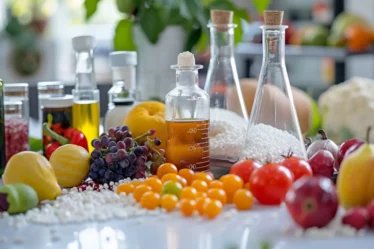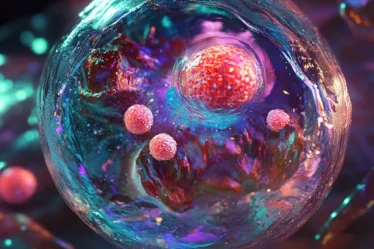
White blood cells catch bacteria by wrapping their membrane around them and forming a vesicle. The cell doesn’t move or grab anything—it changes shape from the inside. This is how materials enter the cell without breaking the membrane or letting in unwanted substances.
This study guide explains endocytosis, including phagocytosis, pinocytosis, and clathrin-mediated endocytosis. You’ll learn how the membrane bends inward, how vesicles form, and what happens after entry.
Endocytosis: Quick Summary
Do you just need the basics? Here’s a simple explanation of what endocytosis is and how it works:
🟠 Endocytosis is a cellular process where the membrane folds inward to bring substances into the cell as vesicles.
🟠 There are three main types: phagocytosis for large particles, pinocytosis for fluids, and receptor-mediated endocytosis for specific molecules.
🟠 Each vesicle travels through the endocytic pathway, moving from the membrane to early endosomes, then to lysosomes for digestion.
🟠 Exocytosis moves substances out of the cell, doing the opposite of endocytosis by releasing vesicle contents into the environment.
🟠 Real-life examples include neutrophils absorbing bacteria and epithelial cells taking in fluid or cholesterol.
What is Endocytosis?
Endocytosis happens when the cell membrane bends inward and forms a pocket that pulls material into the cell. This pocket closes, pinches off, and becomes a vesicle inside the cytoplasm. The vesicle protects the material and moves it to where the cell needs it. The membrane reshaping relies on proteins that push or pull from inside the cell.
Cells use endocytosis to take in larger particles or liquids that can’t pass through membrane channels. It helps the cell control what enters and safely move larger objects. The process also supports cleanup and defense. The type of material taken in determines how the cell responds.
Cells absorb material this way to:
- Keep internal balance
- Bring in large particles or clumps
- Remove damaged parts of the cell
- Trap bacteria or viruses
Common substances taken in by endocytosis:
- Nutrients such as iron, cholesterol, or proteins
- Fluids that contain dissolved molecules
- Cell debris and worn-out parts
- Pathogens like viruses or bacteria
Endocytosis gives cells a way to shape their environment. Instead of letting material drift in freely, the cell wraps it in a membrane and pulls it inside. This process happens in many cell types, from simple organisms to human cells.
Comparison of Endocytosis Types
| Type | Particle Size | Vesicle Type | Triggered by |
| Phagocytosis | Large | Phagosomes | Contact with solid particles |
| Pinocytosis | Small | Small fluid-filled vesicles | Fluid absorption |
| Receptor-mediated | Specific | Clathrin-coated vesicles | Receptor binding |
Recognize the Main Types of Endocytosis
Cells absorb substances in different ways depending on what they need. Endocytosis works through three main processes: phagocytosis, pinocytosis, and receptor-mediated endocytosis. Each follows a distinct mechanism and brings in specific materials.
Phagocytosis Engulfs Large Particles
Phagocytosis targets solid materials like bacteria or dead cells. The cell detects the particle and extends parts of its membrane around it. These arms, called pseudopodia, slowly surround the object and close to form a phagosome.
White blood cells rely on this method to absorb harmful bacteria. Once inside, the phagosome fuses with a lysosome, and enzymes break down the contents. This keeps the internal environment clean and balanced.
Pinocytosis Absorbs Fluid and Solutes
Pinocytosis works without any specific signal. The cell constantly takes in small amounts of extracellular fluid. The membrane dips inward and forms small vesicles filled with fluid and dissolved solutes.
This process doesn’t use receptors. It happens all the time in many cell types. It helps the cell stay in balance with its surroundings and refresh its internal fluid composition.
Clathrin-Mediated Endocytosis Is Receptor-Specific
This type begins when a molecule binds to a receptor on the cell surface. The area around the receptor then folds in and forms a coated pit lined with the protein clathrin. As the pit deepens, it pinches off into a vesicle that carries the molecules inside.
This method is fast and selective. It collects substances like cholesterol, vitamins, and hormones.
Key characteristics of receptor-mediated endocytosis
- High specificity
- Rapid uptake
- Involves protein clathrin
Understand the Endocytic Pathway Step by Step
Once endocytosis begins, the cell follows a clear route to manage what it takes in. You can break this path into five main stages, each involving different organelles.
The first step happens at the plasma membrane. When the membrane surrounds a substance, it folds inward and forms a vesicle. This vesicle separates from the membrane and moves into the cytoplasm.
Then, the vesicle travels along protein tracks. It uses motor proteins to reach the early endosome, which acts like a checkpoint. At this stage, the cell decides what to recycle and what to send forward.
Next comes the late endosome. The vesicle changes as its interior becomes more acidic. This environment helps prepare the material for digestion. The outer layer of the vesicle often changes too.
In the final step, the late endosome fuses with a lysosome. This organelle contains enzymes that break down the contents into smaller molecules. These broken-down parts can then enter the cytoplasm, while waste exits the cell.
Each part of this route has a specific task. The pathway is fast and efficient. Cells use it constantly to control what enters and how it gets processed.
Organelles involved in the endocytic pathway
- Plasma membrane
- Early endosome
- Late endosome
- Lysosome
You should link each organelle to its job: the membrane captures, the early endosome sorts, the late endosome prepares, and the lysosome digests. This system helps the cell stay balanced and clean without wasting energy or time.
Track What Happens After Vesicle Fusion
Once digestion finishes inside the lysosome, the cell doesn’t waste what’s left. Useful molecules like amino acids or sugars move into the cytoplasm for reuse. Any leftovers that can’t be used get packaged again and moved to the membrane for removal. This final step keeps the cell clean and efficient. You can trace each part—from vesicle formation to waste removal—by following changes in the vesicle’s contents and membrane proteins. It’s a full recycling system.
See the Difference Between Endocytosis and Exocytosis
Exocytosis moves material out of the cell. Vesicles formed inside the cell carry substances to the plasma membrane. When the vesicle reaches the surface, it fuses with the membrane and releases its contents into the space around the cell.
This is the opposite of endocytosis, where the cell brings substances in. Endocytosis forms vesicles from the outer membrane to pull material inside. Exocytosis sends material in the other direction—from the inside to the outside.
The two processes look similar but do opposite tasks. In exocytosis, the vesicle content often includes proteins, waste, or signaling molecules that the cell no longer needs or wants to send elsewhere.
Cells use exocytosis to release enzymes, remove waste, or send out chemical messages. It also helps maintain the balance of membrane surface area, since every fusion adds membrane back to the cell surface.
Endocytosis and exocytosis work side by side to keep the cell’s internal environment steady. One process brings in what’s needed, the other removes what’s not. This constant exchange helps the cell stay organized and functional. You can follow the direction of vesicles to tell which process is taking place: in or out.
Check Real Cell Examples of Endocytosis
You can see how endocytosis works by looking at two examples: how immune cells attack bacteria and how other cells absorb fluid or molecules.
Immune Response with Phagocytosis
Neutrophils defend your body by absorbing and destroying bacteria. When they detect foreign particles, they stretch their membrane around the target. This forms a vesicle called a phagosome.
The phagosome moves into the cytoplasm and joins with a lysosome. Inside, enzymes break down the contents. This protects tissues by removing harmful bacteria. For instance, when you get a cut, neutrophils quickly reach the wound and absorb bacteria before they spread.
Nutrient Absorption in Cells
Cells also use endocytosis to take in materials they need. Epithelial cells absorb fluid and solutes through pinocytosis. The membrane creates small pockets that form vesicles filled with fluid, which are pulled into the cell.
Another example is how your cells take in cholesterol. On the surface, there are receptors that recognize cholesterol. When cholesterol binds to them, the membrane folds inward and forms a clathrin-coated vesicle. Once inside, the vesicle releases the cholesterol where the cell can use it for building membranes.
These examples show how cells absorb different materials—large solid particles, fluids, or specific molecules. They use different forms of endocytosis depending on what they need to take in and how. Each step is controlled and follows a clear sequence, so the cell knows exactly what it’s absorbing and where to send it.
Get Extra Help with Endocytosis through Private Tutoring
Struggling with endocytosis? You’re not alone. Between vesicle formation, phagocytosis, pinocytosis, and all the steps in the endocytic pathway, it’s easy to feel lost. A private chemistry tutor for high school can help you slow things down, break it apart, and actually make sense of what’s going on inside the cell.
Whether you prefer online lessons or in-person sessions, there’s always someone nearby. Try searching “chemistry tutor Leeds” or “tutoring chemistry Manchester” to find help that fits your schedule. You’ll go over real examples—how neutrophils take in bacteria, or how cells absorb cholesterol—and figure out exactly what matters for your exams.
If you’re stuck on clathrin-coated vesicles or how materials end up in lysosomes, one-on-one chemistry tutoring clears it up. A tutor makes sure you don’t just memorize it—you actually get it. You’ll cover the details and work through questions at your pace, without pressure.
Want to feel more prepared? Try “chemistry tutoring Liverpool” or “private chemistry tutor Sheffield” and start with just one class. It might be all you need to make things click. Book your session on meet’n’learn.
Looking for more resources? Check out our Biology blogs for additional learning material. If you’re ready for extra help, a tutor can guide you through the most challenging topics with clarity and patience.
Endocytosis: Frequently Asked Questions
1. What is endocytosis?
Endocytosis is the process where a cell brings substances into its interior by forming vesicles from the plasma membrane.
2. What are the main types of endocytosis?
The main types of endocytosis are phagocytosis, pinocytosis, and receptor-mediated endocytosis.
3. How does phagocytosis work?
Phagocytosis works by the cell surrounding large particles with its membrane and forming a vesicle to absorb them.
4. What does pinocytosis absorb?
Pinocytosis absorbs fluids and small solutes through small, continuously forming vesicles.
5. What triggers receptor-mediated endocytosis?
Receptor-mediated endocytosis starts when specific molecules bind to receptors on the cell surface.
6. How is exocytosis different from endocytosis?
Exocytosis moves substances out of the cell, while endocytosis brings substances in.
7. Which organelles are involved in endocytosis?
Organelles involved in endocytosis include the plasma membrane, early endosome, late endosome, and lysosome.
8. Can endocytosis help remove cell debris?
Yes, cells can remove cell debris through phagocytosis, especially during immune responses.
Sources:



